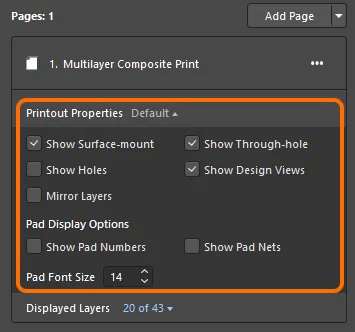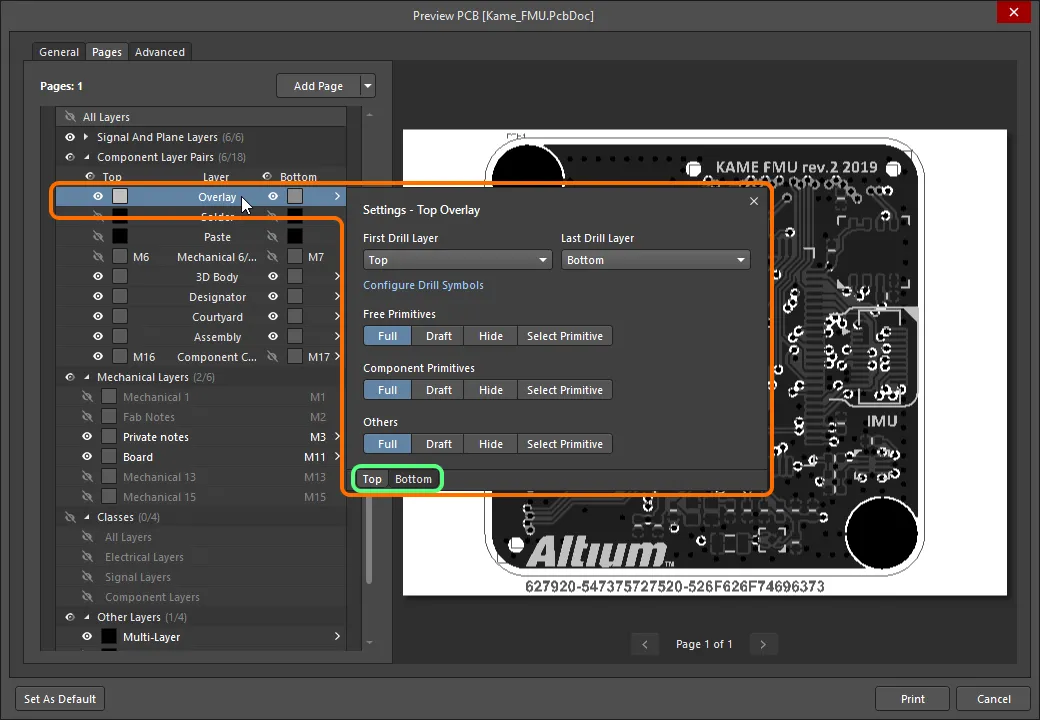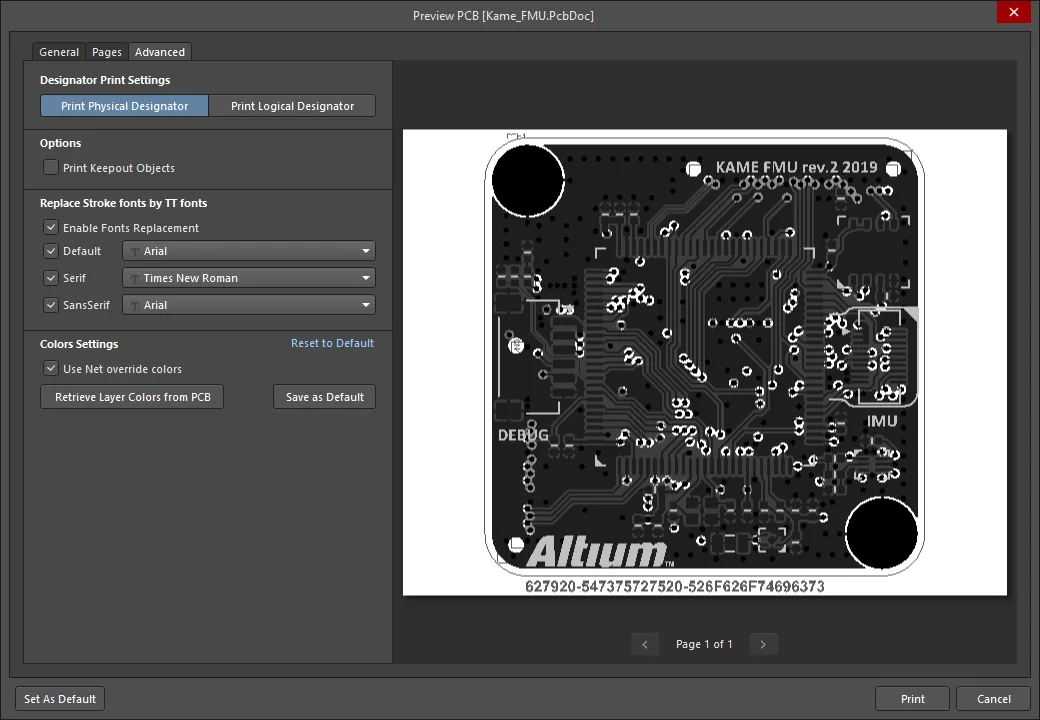General Tab

The General tab has options to configure your printer and page settings.
Print & Presets Settings
Page Settings
- Color Set – use this option to choose which color set you want to use for the printed output. Available color sets are: Gray, Mono, and Color.
- Page Size – select a paper size from the drop-down.
- Orientation – use these options to choose between printing in Portrait or Landscape orientation.
Scale & Position Settings
- Scale Mode – use the drop-down to select the mode of scaling desired. Choose from
Actual Size or Fit On Page.
- Scale – this field is available when Scale Mode is set to
Actual Size. Use it to define how much the document is scaled. Entering a value greater than 1 will essentially enlarge the print (a zoomed-in effect), while entering a value less than 1 will shrink it (a zoomed-out effect).
- Horizontal Offset – use to manually adjust the position of the printed content on the page in the horizontal plane. Enter a positive value to shift the printed content to the right on the page or a negative value to shift it left. If the field is set to zero, the minimum horizontal left-hand margin required by the printer is used. Enable the Center option to automatically position the printed content so that it is centered horizontally on the page.
- Vertical Offset – use to manually adjust the position of the printed content on the page in the vertical plane. Enter a positive value to shift the printed content upward on the page or a negative value to shift it downward. If the field is set to zero, the minimum vertical bottom margin required by the printer is used. Enable the Center option to automatically position the printed content so that it is centered vertically on the page.
Area to Print
- Type – use the controls in this region to determine the area of the board to be printed. Choose from:
- Entire Sheet – print the whole board.
- Specific Area – only print the defined area. With this option enabled, the following controls become available:
- Start Point (X/Y) – use these fields to define the X and Y coordinates for the bottom-left corner of the required print area.
- End Point (X/Y) – use these fields to define the X and Y coordinates for the top-right corner of the required print area.
- Select Area on PCB – use this button to interactively define the area to be printed in the PCB document design space.
Pages Tab

The Pages tab includes display options, options to manage layer settings, and allows you to add/remove pages.
- Add Page – click the button to add a new page with default settings and no layer selected. Click the drop-down arrow associated to the button to access the available options as follows:
- Create Final – use to quickly create a complete, predefined final artwork print-set for the source PCB document.
- Create Composite – use to quickly create a predefined multi-layer composite print for the source PCB document.
- Create Power-Plane Set – use to quickly create predefined power-plane drawings for the source PCB document.
- Create Mask Set – use to quickly create predefined solder/paste mask drawings for the source PCB document.
- Create Drill Drawings – use to quickly create a predefined set of drill drawings and guides for the source PCB document.
- Create Assembly Drawings – use to quickly create predefined assembly drawings for the source PCB document.
- Create Composite Drill Guide – use to quickly create a predefined composite drill drawing for the source PCB document.
- Page list – the list of pages to be printed. Each page is represented by its tile where from the following options can be accessed:
-
 – use the ellipsis button to access the page management options:
– use the ellipsis button to access the page management options:
- Edit – use this option to change the name of the page as desired, giving a more meaningful name that will readily identify its nature and purpose.
- Move Page Up / Move Page Down – use these options to change the position of the page in the list, which changes the print rendering order.
- Delete Page – use this option to remove the page from the list.
-
Printout Properties – use the control at the right to access various printout property options. Depending on the state of these options, the control will be shown as Default or Custom. The options may be enabled to control which components are included in associated printouts (such as whether or not you choose to show surface-mounts), as well as additional controls (such as mirroring layers and the size of the font used for pad numbers and net text).

-
Displayed Layers – use the control at the right to access the options to manage the list of layers and their display settings for the current page. The numbers in the control represent how many layers from the overall number of PCB layers are selected for the page.

-
 – use this control to switch between
– use this control to switch between Displayed Layers mode to select layers to be printed and Displayed Layer Order mode to define order of the selected layers.
- In
Displayed Layers mode, use the  /
/ icon for a layer or a layer group to enable/disable it for the current page.
icon for a layer or a layer group to enable/disable it for the current page.
- In
Displayed Layer Order mode, use the  buttons to move the selected layer up and down in the list.
buttons to move the selected layer up and down in the list.
-
 – click to access the search field. Start typing in the field to show only the layers containing the search string in their names.
– click to access the search field. Start typing in the field to show only the layers containing the search string in their names.
- Click the color button to change that layer's color.
-
Click the name of an enabled to show the settings pop-up where you can configure additional settings for the selected layer.
When the name of a component layer pair with both layers selected is clicked in Displayed Layers mode, use the tabs at the bottom of the pop-up to switch between settings for the Top and Bottom layers of the pair.

- First Drill Layer / Last Drill Layer – use these fields to specify the starting and finishing layer for the required drill pair. The drop-down lists all available signal and internal plane layers defined in the board's layer stack.
- Configure Drill Symbols – click this control to open the Drill Symbol dialog, where you may assign symbols/letters to each drill size.
- Free Primitives – this drop-down provides controls to determine how the free primitives on a layer are displayed on the printout. For the following free primitive objects, use the associated drop-down field to choose whether to display the object fully (
Full), in outline mode only (Draft), or hide the object (Hide). Choose Select Primitive to set individual settings for each relevant object type.
- Component Primitives – this drop-down provides controls to determine how the component primitives on a layer are displayed on the printout. For the following component primitive objects, use the associated drop-down field to choose whether to display the object fully (
Full), in outline mode only (Draft), or hide the object (Hide). Choose Select Primitive to set individual settings for each relevant object type.
- Other – this region provides controls to determine how other objects on a layer are displayed on the printout. For the following objects, use the associated drop-down field to choose whether to display the object fully (
Full), in outline mode only (Draft), or hide the object (Hide). Choose Select Primitive to set individual settings for each relevant object type.
Advanced Tab

The Advanced tab provides designator setting options as well as font and color options.
Designator Print Settings
Use the control in this region to specify the type of designator information to be included on the printouts. Choose from the drop-down to either Print Physical Designators or Print Logical Designators.
Options
Print Keepout Objects – enable this option to have keepout-designated design objects included on the printed document.
Replace Stroke fonts by TT fonts
- Enable Fonts Replacement – check this box to enable the ability to replace fonts.
- Default – check the box to use default settings. You may use the drop-down to change the font.
- Serif – check this box to use the Serif font. You may use the drop-down to change the font.
- Sans Serif – check this box to use the Sans Serif font. You may use the drop-down to change the font.
Colors Settings
- Use Net override color – enable this option to have the net color used in prints rather than the layer color.
- Retrieve Layer Colors from PCB – click this button if you want to print using the same colors configured for the PCB design in the PCB Editor.
- Save as Default – click to overwrite default color set with your local color set.
Preview Right-Click Menu
Right-click within the Preview area to access the following menu:
- Copy – use this command to copy the current preview to the Windows Clipboard.
- Zoom In – use this command to incrementally zoom in.
- Zoom Out – use this command to incrementally zoom out.
- Show Print Region – use this command to show the region that will print.
- Show Grid – use this command to show grid lines in the preview area. Note the grid lines will not be displayed on your printout.
- Export to Image – use this command to export the current preview as an image (PNG, JPEG, BMP, GIF, WMF, EMF).
Additional Controls
Set as Default – use to set the predetermined settings on Pages and Advanced tabs of the dialog as default.